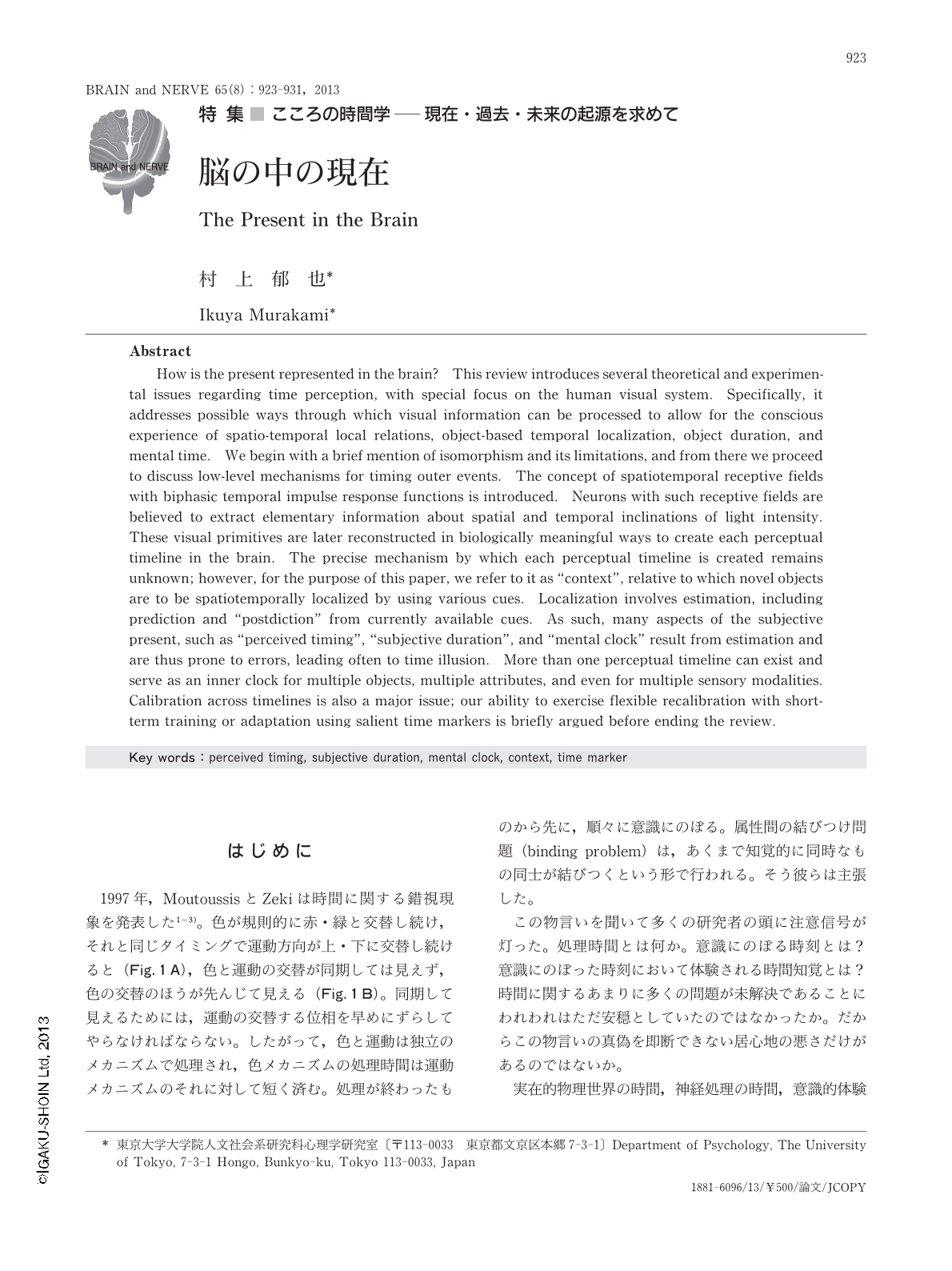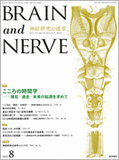Japanese
English
- 有料閲覧
- Abstract 文献概要
- 1ページ目 Look Inside
- 参考文献 Reference
はじめに
1997年,MoutoussisとZekiは時間に関する錯視現象を発表した1-3)。色が規則的に赤・緑と交替し続け,それと同じタイミングで運動方向が上・下に交替し続けると(Fig.1A),色と運動の交替が同期しては見えず,色の交替のほうが先んじて見える(Fig.1B)。同期して見えるためには,運動の交替する位相を早めにずらしてやらなければならない。したがって,色と運動は独立のメカニズムで処理され,色メカニズムの処理時間は運動メカニズムのそれに対して短く済む。処理が終わったものから先に,順々に意識にのぼる。属性間の結びつけ問題(binding problem)は,あくまで知覚的に同時なもの同士が結びつくという形で行われる。そう彼らは主張した。
この物言いを聞いて多くの研究者の頭に注意信号が灯った。処理時間とは何か。意識にのぼる時刻とは? 意識にのぼった時刻において体験される時間知覚とは? 時間に関するあまりに多くの問題が未解決であることにわれわれはただ安穏としていたのではなかったか。だからこの物言いの真偽を即断できない居心地の悪さだけがあるのではないか。
実在的物理世界の時間,神経処理の時間,意識的体験としての時間の間の関係に関する著名な実験報告例は過去にもあったものの4),上記の発表が1つの里程標となって,視覚科学において,これらの深遠な関係に改めて人々の目が向くようになったのは間違いない。しかし,これらの関係はいまだ十分に解明されたとは言い難い。時間とは何かを問おうとすれば,意識とは何かを問うハードプロブレムに接近しやすく,どういった外堀から埋めていくかが決め難いのかもしれない。
本稿では主に視覚システムを対象として,現在の時を刻む神経実体にどういうものがありうるか,視覚オブジェクトがいつどこにあるかを定めるにはどうすべきか,つくり出される現在にはどのような様相があるか,などについて研究知見を紹介し実験心理学の現況報告をすることを目的とする。
Abstract
How is the present represented in the brain? This review introduces several theoretical and experimental issues regarding time perception, with special focus on the human visual system. Specifically, it addresses possible ways through which visual information can be processed to allow for the conscious experience of spatio-temporal local relations, object-based temporal localization, object duration, and mental time. We begin with a brief mention of isomorphism and its limitations, and from there we proceed to discuss low-level mechanisms for timing outer events. The concept of spatiotemporal receptive fields with biphasic temporal impulse response functions is introduced. Neurons with such receptive fields are believed to extract elementary information about spatial and temporal inclinations of light intensity. These visual primitives are later reconstructed in biologically meaningful ways to create each perceptual timeline in the brain. The precise mechanism by which each perceptual timeline is created remains unknown; however, for the purpose of this paper, we refer to it as "context", relative to which novel objects are to be spatiotemporally localized by using various cues. Localization involves estimation, including prediction and "postdiction" from currently available cues. As such, many aspects of the subjective present, such as "perceived timing", "subjective duration", and "mental clock" result from estimation and are thus prone to errors, leading often to time illusion. More than one perceptual timeline can exist and serve as an inner clock for multiple objects, multiple attributes, and even for multiple sensory modalities. Calibration across timelines is also a major issue; our ability to exercise flexible recalibration with short-term training or adaptation using salient time markers is briefly argued before ending the review.

Copyright © 2013, Igaku-Shoin Ltd. All rights reserved.


